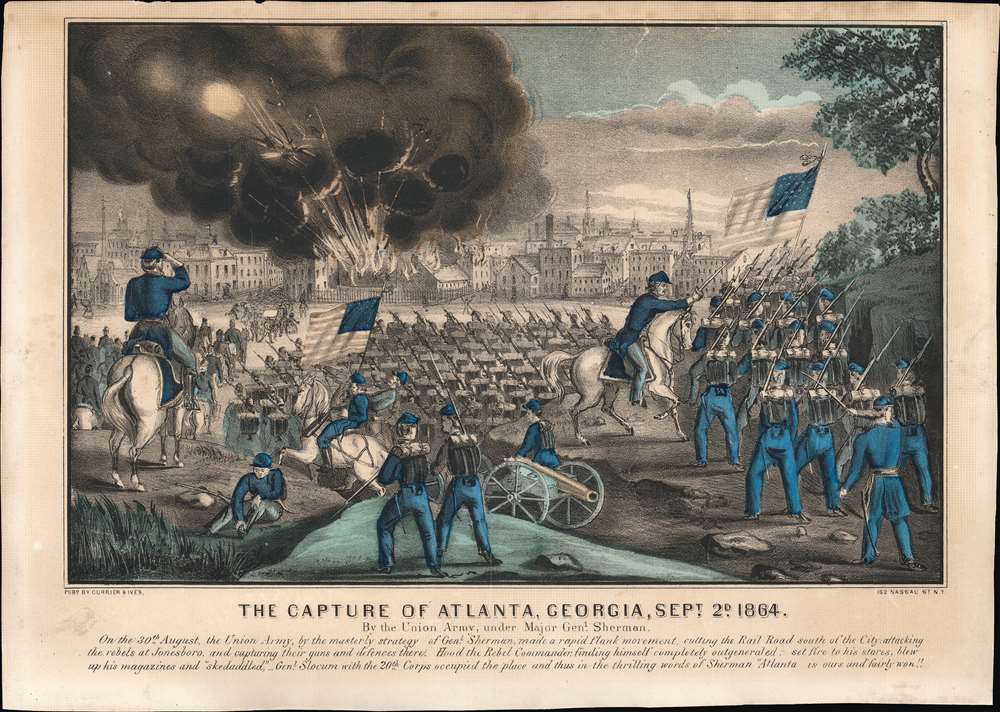1864 Currier / Ives Print of the Battle of Atlanta, U.S. Civil War
Atlanta-currierives-1864
Title
1864 (undated) 8 x 12.5 in (20.32 x 31.75 cm)
Description
A Closer Look
This print shows Union troops marching into the city of Atlanta on September 2, 1864, just after its abandonment by Confederate forces under Gen. John Bell Hood. The exploded Confederate magazines, an act of scorched earth warfare by Hood, are depicted prominently near center. A group of civilians stands near the outskirts of the city with a flag of surrender. The officer on horseback near center may be a representation of Gen. Henry Slocum, mentioned in the description below the image.The Battle of Atlanta
Gen. William Tecumseh Sherman's capture of Atlanta in July-September 1864 and the subsequent 'March to the Sea' are often seen as the 'nail in the coffin' of the Confederacy. Following Union victories at Gettysburg and Vicksburg the previous summer, momentum had shifted against the Confederacy, but the war's conclusion was far from certain. Gen. Ulysses Grant was put in command of Union forces in March 1864 and pursued a multi-pronged attack on the Confederacy, leveraging the Union's superiority in manpower and materiel. Sherman, one of Grant's most trusted generals, took on Grant's previous role as commander of the Western Theater.Heading an army of nearly 100,000 troops, Sherman marched into Georgia, occasionally engaging Confederate troops but focusing primarily on employing scorched earth tactics that paralyzed already strained Confederate supply lines. Meanwhile, Gen. John Bell Hood took command of opposing Confederate forces from the more cautious Joseph Johnston. Hood's tendency to attack Sherman's much larger force only made Sherman's task easier. By late July, Sherman's army reached the outskirts of Atlanta. A failed attack by the just-appointed Hood on July 22 killed Union Gen. James McPherson but otherwise achieved little, setting the tone for the following weeks, as Sherman maneuvered to surround and cut off the city. On September 1, facing complete envelopment of his army, Hood evacuated Atlanta and burned his remaining ammunition to prevent it falling into Union hands, setting off tremendous explosions, shown here.
Although still a relatively small city at the time, Atlanta was the rail hub of the Confederacy, and, along with Sherman's 'March to the Sea,' the capture of the city effectively cut the Confederacy (which was also embargoed by the Union Navy on three sides) in half. After evacuating the city of civilians and just before embarking on the march to Savannah, Sherman's forces burned Atlanta to prevent it being used again as a supply hub. Hood's army escaped but was later decisively defeated in Tennessee in the closing weeks of the year. The capture of Atlanta was a major morale boost to the Union cause and came just a month before the 1864 Presidential Election, helping Abraham Lincoln easily win reelection.
Publication History and Census
This print was published by Charles Currier and James Ives in 1864 or early 1865. Although their images of the Civil War are iconic, original Currier and Ives prints are difficult to come by. We are only able to locate institutional holdings of this print with the Boston Athenaeum, the American Antiquarian Society, and the Museum of the City of New York.CartographerS
Charles Jacob Currier (February 8, 1819 - December 4, 1887) was an American publisher, lithographer, and engraver active in New York during the second half of the 19th century. He was born in Roxbury, Massachusetts. Currier is often overshadowed by his older brother, Nathaniel Currier, of the Currier and Ives firm. While Charles Currier is sometimes associated with Currier and Ives, and with Nathaniel Currier separately, he also published independently under his own imprint. It was Charles Currier who introduced Nathaniel Currier (1813 - 1888), to his brother-in-law James Merritt Ives (1824 - 1895), who eventually partnered in 1857 to found one of the predominate graphic publishing firms in American history, Currier and Ives. He died in Brookline, Massachusetts and is buried in Greenwood Cemetery, Brooklyn. More by this mapmaker...
James Merritt Ives (March 5, 1824 - January 3, 1895) was an American businessman, bookkeeper, and lithographer who oversaw the business side of the famed lithographic firm Currier and Ives. Born in New York City, Ives was a self-trained artist who began working at the age of twelve. He married Caroline Clark (1827 - 1896) on June 24, 1846, who was the sister-in-law of Nathaniel Currier's brother, Charles Currier. In 1852, Nathaniel Currier (March 27, 1813 - November 20, 1888) hired Ives as the bookkeeper for his firm N. Currier, Lithographer, on Charles's recommendation. Ives' talent for art and his knowledge of the artistic world soon became apparent to Currier, who valued his insights as well as the business acumen. Currier offered Ives a full partnership in 1857. They renamed the firm 'Currier and Ives' with Ives as the general manager. Ives began to play a role in selecting artists and prints to publish, and was responsible for pursuing publication of scenes of middle-class America that made the firm famous. After Ives died in 1895, his sons continued to work with Currier's son to manage the firm until it was liquidated in 1907. Learn More...

